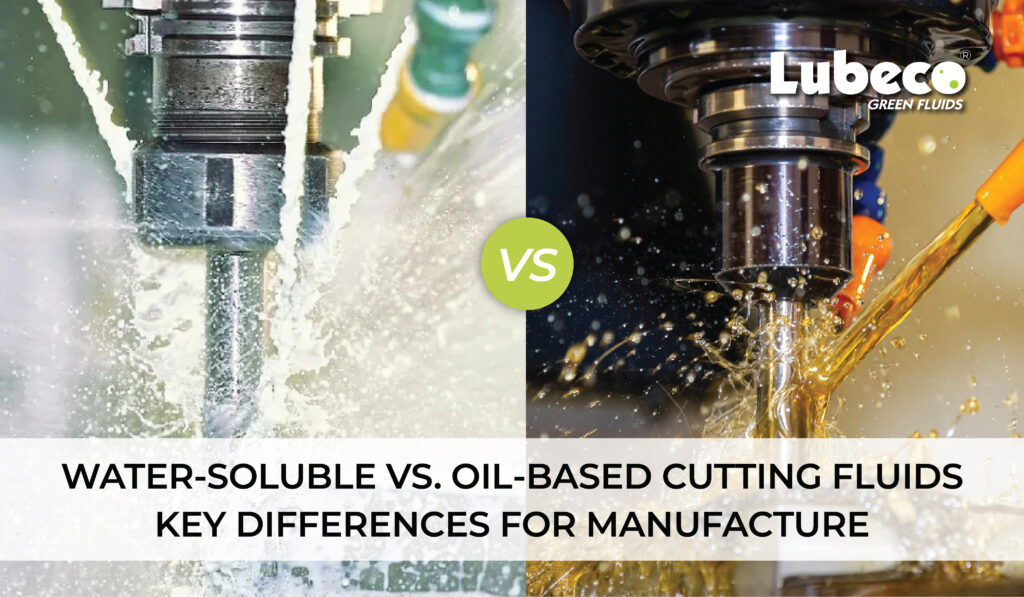Cutting fluids are essential in the manufacturing industry, playing a crucial role in machining processes by reducing heat, friction, and wear on cutting tools. Two major types of cutting fluids dominate the industry: water-soluble and oil-based cutting fluids.
Understanding the key differences between these fluids can help manufacturers choose the best option for specific applications, improving efficiency, extending tool life, and reducing production costs.
What Are Cutting Fluids?
Cutting fluids are lubricants and coolants used in machining processes like drilling, milling, turning, and grinding. They serve three primary functions:
- Cooling: Reducing heat generated by friction and deformation.
- Lubrication: Minimizing wear between the cutting tool and workpiece.
- Chip Removal: Helping remove metal particles and debris.
Choosing the right cutting fluid is critical, as it directly impacts machining performance, tool longevity, and product quality.
Water-Soluble Cutting Fluids
Water-soluble cutting fluids, also known as water-miscible fluids, contain a mix of water and lubricating oil. These fluids are diluted with water before use, creating emulsions that provide excellent cooling and moderate lubrication.
Types of Water-Soluble Cutting Fluids:
- Soluble Oils: Contain a high percentage of oil, offering good lubrication.
- Semi-Synthetics: A balance of oil and synthetic components for enhanced cooling and lubrication.
- Synthetics: Oil-free fluids providing maximum cooling but limited lubrication.
Advantages of Water-Soluble Cutting Fluids:
- Excellent Cooling: Water dissipates heat effectively, reducing thermal deformation.
- Economical: Lower initial cost due to dilution with water.
- Eco-Friendly Options: Many formulations are biodegradable and less hazardous.
Disadvantages of Water-Soluble Cutting Fluids:
- Rust Risk: Improper maintenance can cause rust on machine parts.
- Bacterial Growth: Susceptible to microbial contamination, requiring biocides.
- Maintenance Intensive: Frequent monitoring and maintenance are needed to ensure optimal performance.
Applications of Water-Soluble Cutting Fluids:
- Light to Medium Machining: Used in industries like automotive and general metal fabrication.
- High-Speed Machining: Effective in operations requiring intensive cooling.
- Aluminum Processing: Suitable for aluminum and non-ferrous metals.
Oil-Based Cutting Fluids
Oil-based cutting fluids are primarily composed of mineral or synthetic oils, offering superior lubrication. They are used in undiluted form, making them ideal for heavy-duty machining operations.
Types of Oil-Based Cutting Fluids:
- Straight Oils: Pure oils offering maximum lubrication.
- Additive-Enhanced Oils: Contain performance-enhancing additives like sulfur or chlorine.
Advantages of Oil-Based Cutting Fluids:
- Superior Lubrication: Reduces tool wear and friction in high-pressure operations.
- Corrosion Resistance: Forms a protective layer against rust.
- Longer Fluid Life: More stable and less prone to microbial degradation.
Disadvantages of Oil-Based Cutting Fluids:
- Lower Cooling Ability: Limited heat dissipation compared to water-soluble fluids.
- Higher Cost: More expensive due to undiluted usage.
- Environmental Concerns: Disposal and handling may involve stricter environmental regulations.
Applications of Oil-Based Cutting Fluids:
- Heavy-Duty Machining: Ideal for steel, titanium, and nickel-based alloys.
- Precision Manufacturing: Widely used in aerospace, automotive, and tooling industries.
- Gear and Bearing Manufacturing: Preferred in high-torque and high-load environments.
Key Differences Between Water-Soluble and Oil-Based Cutting Fluids
| Feature | Water-Soluble Cutting Fluids | Oil-Based Cutting Fluids |
| Composition | Water and oil emulsion | Mineral or synthetic oil |
| Cooling Ability | Excellent | Moderate |
| Lubrication | Moderate | Superior |
| Corrosion Protection | Needs additives | Naturally resistant |
| Cost | Lower (dilutable) | Higher (undiluted) |
| Maintenance | Frequent monitoring needed | Low-maintenance |
| Environmental Impact | Biodegradable options | Disposal challenges |
| Applications | Light to medium machining | Heavy-duty operations |
Factors to Consider When Choosing a Cutting Fluid
- Machining Process: Consider whether the operation requires more cooling or lubrication.
- Workpiece Material: Materials like aluminum benefit from water-soluble fluids, while tough metals like titanium may require oil-based options.
- Tool Life and Performance: Optimize cutting fluid selection to extend tool life and enhance product quality.
- Environmental and Regulatory Compliance: Ensure compliance with environmental standards and safe disposal practices.
- Operational Costs: Balance fluid costs, maintenance, and disposal expenses.
Best Practices for Cutting Fluid Management
- Regular Monitoring: Check fluid concentration, pH, and contamination levels.
- Proper Filtration: Use filtration systems to remove metal particles and extend fluid life.
- Storage and Handling: Store cutting fluids in suitable containers and conditions.
- Disposal Compliance: Follow local regulations for safe disposal.
- Training and Safety: Train staff on safe handling, usage, and maintenance procedures.
Emerging Trends and Innovations in Cutting Fluids
The cutting fluid industry is constantly evolving with new innovations aimed at improving performance, sustainability, and cost-effectiveness:
- Nano-Enhanced Fluids: Cutting fluids infused with nanoparticles for improved lubrication and thermal conductivity.
- Eco-Friendly Formulations: Biodegradable and low-toxicity fluids that reduce environmental impact.
- Smart Fluid Management Systems: Automated systems that monitor fluid properties in real-time to ensure optimal performance.
- Recyclable Fluids: Advanced technologies that enable fluid recycling and reuse, reducing operational costs.
Maintenance for Cutting Fluids
Proper maintenance of cutting fluids is essential for maximizing tool life, ensuring machining efficiency, and maintaining a safe working environment. Neglecting maintenance can result in reduced performance, bacterial growth, rust formation, and increased operational costs.
Key Maintenance Practices:
- Regular Monitoring: Check cutting fluid concentration, pH levels, and temperature regularly. Use a refractometer to ensure the correct concentration.
- Filtration and Cleaning: Install filtration systems to remove metal chips, dirt, and debris. Periodically clean the fluid tank to prevent sludge buildup.
- Bacterial Control: Use biocides or antimicrobial additives to prevent bacterial and fungal growth, which can cause foul odors and reduce fluid life.
- Coolant Replenishment: Replenish cutting fluids as needed to maintain optimal levels. Avoid mixing different fluid types to prevent chemical imbalances.
- Rust Prevention: Add rust inhibitors to water-soluble fluids to protect machine components from corrosion.
- Disposal and Recycling: Follow environmental guidelines for fluid disposal or consider recycling systems to reduce waste and costs.
Consistent maintenance helps prolong fluid life, reduces downtime, and ensures high-quality machining performance. Implementing a maintenance schedule keeps operations running smoothly while minimizing health, safety, and environmental risks.
Let’s Conclude
Choosing between water-soluble and oil-based cutting fluids depends on specific machining needs, workpiece materials, and operational priorities.
Water-soluble fluids excel in cooling and cost-effectiveness, while oil-based fluids offer superior lubrication and longevity.
By understanding their key differences, manufacturers can make informed decisions, optimizing production processes, reducing downtime, and ensuring high-quality outputs.
Staying updated with emerging technologies and best practices can further enhance productivity, minimize environmental impact, and reduce operational costs, securing a competitive edge in the modern manufacturing landscape.
FAQ’s
- Which cutting fluid is better for high-speed machining? Water-soluble cutting fluids are ideal due to their superior cooling capabilities.
- Are oil-based cutting fluids environmentally friendly? They can be challenging to dispose of but are often more stable and less prone to contamination.
- How can I prevent rust when using water-soluble cutting fluids? Regular maintenance and adding rust inhibitors can reduce rust formation.
- What industries commonly use oil-based cutting fluids? Aerospace, automotive, and heavy-duty machining industries frequently use oil-based fluids.
- How often should cutting fluids be monitored? Regular monitoring, ideally weekly, ensures optimal performance and fluid longevity.










